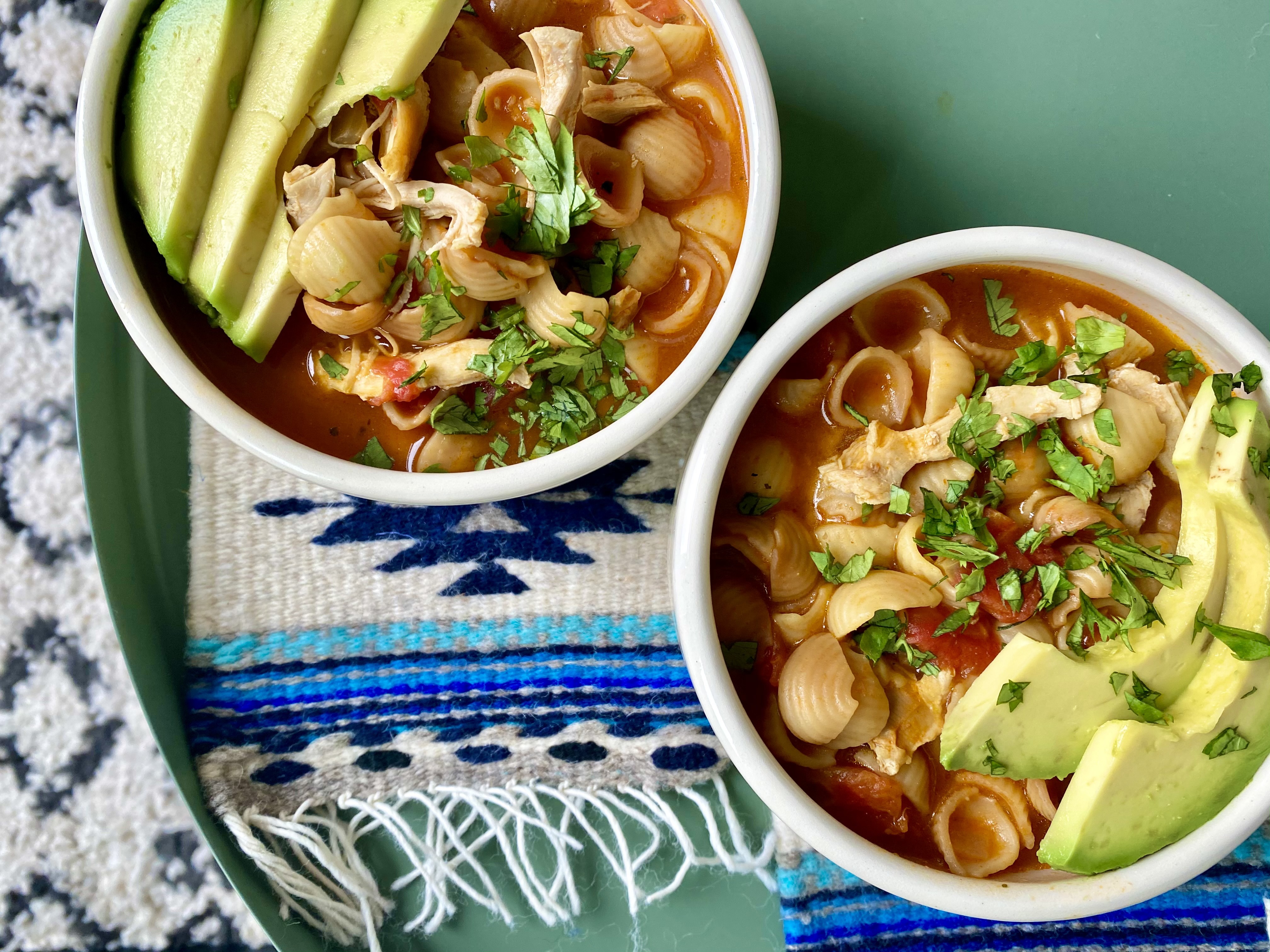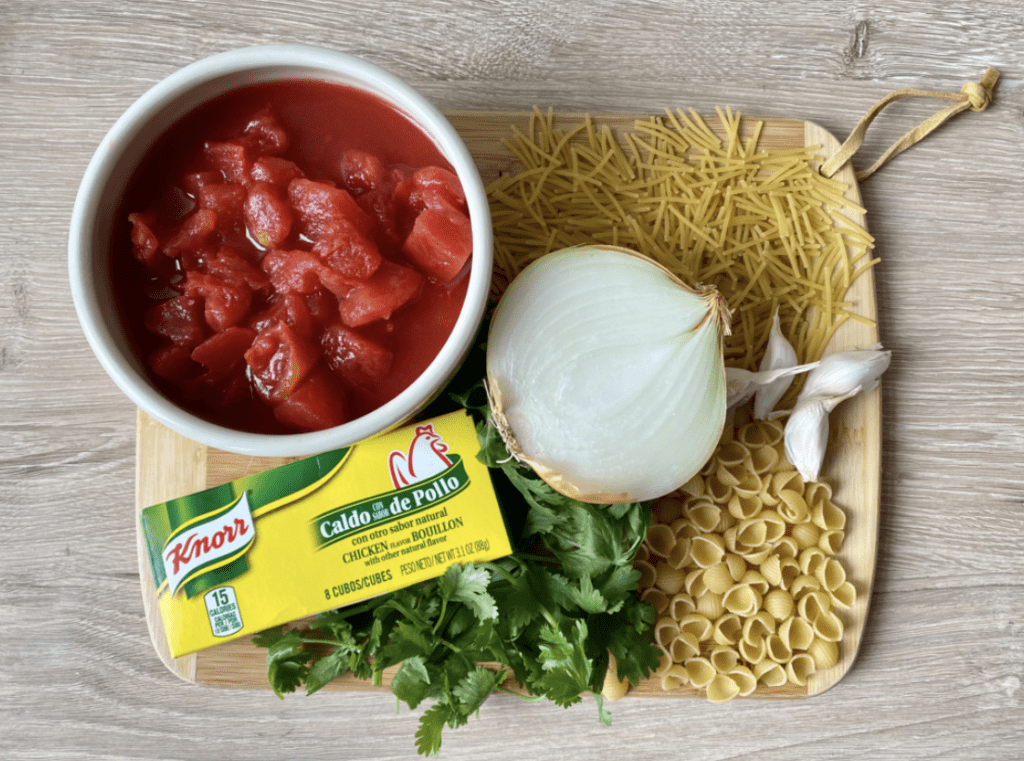
Historias de la Cocina: Sopa de Fideo (Mexican Noodle Soup)
The beloved tomato-spiced noodle soup has roots in Italy and Spain.
As soon as the first chilly day rolls around each year, my internal soup mode switches on. I love soup. I’ll scream it from the rooftops. And once I can acceptably eat it most days of the week? I’m in heaven (Although, if we’re being honest, I have been known to eat boiling hot soup in the dead of summer, too). Now that the leaves have started to change and we’re officially in the autumn months, it’s time to start making soup in my house.
The best types of soups, in my opinion, are the ones that are deeply flavorful but simple in ingredients and preparation. I’m a sucker for noodle soups — I’d gladly eat my weight in any spicy ramen, pho, or udon situation — but the noodle soup I grew up eating on a weekly basis, and therefore ranks number one in my heart, is sopa de fideo, or Mexican noodle soup.
Traditional fideo noodles come packaged one of two ways: as long noodles dried into little nests or short noodles that resemble cut up spaghetti, around an inch long. Fideos are made of durum wheat and water and are then rolled out, dried, and cut to a thickness between angel hair and spaghetti (although I’ve seen pasta the thickness of spaghetti in some dishes). Aside from the textbook definition of fideo as a thin, straight noodle, many Mexican families, mine included, think of fideos as all different shaped noodles that can be used in sopa de fideo. Some popular shapes are estrellas (stars), letras (letters), semillas de melon (melon seeds) and conchitas (little shells).
Sopa de fideo is a unique dish in that it’s one of the very few Mexican dishes formed around pasta. Aside from the birria ramen trend that has gained popularity in Southern California over the last few years and the general Mexican love for instant cup noodles (covered in lime and Tapatío, of course) there are only a few fideo, or noodle, dishes in traditional Mexican cooking. Sopa de fideo is likely the most popular one, and for good reason — it’s easy, filling, cozy and cooks even faster than a pot of Spanish rice.
The history of Fideos unfolds alongside the history of trade and colonialism between Italy, Spain and Mexico, or “New Spain” as Spanish settlers called Mexico City and surrounding areas. Some historians believe that noodles were brought to both Italy and Spain by Arab nomads. Likely introduced to Spain between the eighth and ninth centuries, these noodles are said to have become known as the fine, thin fideos known today, which were then eventually taken to Mexico during Spanish colonization.
Even indirectly, the dish many Mexicans know as sopa de fideo has a pretty obvious precursor: spaghetti. In his book Que Vivan Los Tamales!: Food and the Making of Mexican Identity, food historian Jeffrey Pilcher says that “Italian dishes appeared prominently in the cuisine of New Spain. Spaghetti with tomato sauce became a common dry soup, fideos.” Although the exact pathway of how spaghetti turned into sopa de fideo from Italy to Spain to Mexico isn’t clear, I can imagine that Mexican cooks began to adapt dishes brought by the Spaniards (some foods with Italian roots) to suit their tastes and cooking methods. Sopa de fideo, although technically a soup, isn’t traditionally very soupy. My guess on the creation of the dish is that it has something to do with adjusting cooking methods for Spanish rice to suit pasta. Since rice absorbs more water than pasta, using a Spanish rice recipe to cook noodles would yield enough liquid to become something between a dry pasta dish and a soup.
Even at first glance, the method for cooking sopa de fideo is quintessentially Mexican. If you can make a pot of arroz rojo, or Spanish rice, you can make sopa de fideo. In the most simple iteration of the dish, thin, broken up noodles are browned in oil before adding onion, garlic, tomato sauce, chicken broth, and spices and simmering until the pasta is tender. This is the exact same process as arroz rojo. The Mexican culinary love for toasting dry starches in oil is as necessary as South Asian cooks blooming their fresh spices in oil — it adds depth, smokeyness and brings out hidden flavors.
I’ve had my mom’s sopa de fideo for dinner more times than I could count. We would eat it for dinner when Mama was too tired to cook anything else, or if the fridge looked a bit empty and we hadn’t gotten around to grocery shopping yet. Like when we made chilaquiles to use up stale tortillas, sopa de fideo is a meal that uses things we almost always already had, which helped my family cut down on buying unnecessary groceries and creating excess food waste. Mexican food culture is truly one of the original low-waste lifestyles.
Our pantry was normally stocked with all different shapes of fideos but most of the time, Mama liked to make sopa de fideo with pasta that looked like tiny shells. My grandma fed the small concha-shaped noodles to my mom when she was young, and Mama carried on the tradition with her children. Mama made her sopa extra garlicky, and usually topped the finished dish with shredded yellow cheese. Whenever I sit down to a bowl of sopa de fideo, it feels like I’m 12 again, being warmed up by hot noodle soup during those chilly mojave desert autumn nights.
Aside from the lovely nostalgia I get from a good bowl of sopa de fideo, its other prime attraction is that the dish is actually ridiculously easy to make. But, if you’re in the mood to dress it up, it’s equally as cooperative. Adding shredded chicken, cilantro, avocado and cheese makes sopa de fideo filling and photo-worthy, but it’s just as delicious all by itself. Just toast the noodles, add garlic, onions, tomato sauce, chicken broth, and spices, and you’ll have a delicious meal in less than 30 minutes. You can also make sopa de fideo without all the spices and it’ll be just as tasty, but a bit more mild.

Photo of ingredients for sopa de fideo by the author.
Sopa de Fideo (Mexican Noodle Soup)
Yield: 4 servings
Time: 20-45 minutes
Ingredients
- 1 ½ lbs. boneless skinless chicken breast or thigh (optional)
- 2 tbsp. neutral cooking oil (preferably canola or vegetable, but olive oil works in a pinch)
- 2 cups pasta (fideos, shells, estrellas, letras, or thin spaghetti, broken up into 1 inch pieces)
- 1 cup Pato sauce or tomato sauce
- 1 cup canned diced tomatoes
- ½ medium yellow onion, finely diced
- 3 cloves garlic, minced
- 4-5 cups chicken or vegetable broth (depending on how soupy you want your fideo)
- ¼ tsp. (preferably Mexican) oregano (optional)
- ¼ tsp. red chile powder (optional)
- ¼ tsp. cumin (optional)
- Salt, to taste
- ⅓ cup queso fresco or shredded cheese, for topping (optional)
- ¼ cup roughly chopped cilantro, for topping (optional)
- 1 large avocado, thinly sliced, for topping (optional)
Preparation
Step 1
If making with chicken, heat a large pot of salted water over high heat until boiling. Lower to medium heat, add chicken and cook until cooked through and tender, about 20-25 minutes. Place cooked chicken on a plate and set aside. Shred once cooled.
Step 2
Heat oil in a large pot over medium-high heat. Add in pasta of choice and brown, stirring constantly, about 2-3 minutes until pasta is golden and toasted. Lower heat to medium-low. Add onion and garlic and sauté another minute until onion begins to turn translucent.
Step 3
Pour in tomato sauce and diced tomatoes, stirring to combine. Allow mixture to come to a slight simmer, until you can see small bubbles around the perimeter of the pot.
Step 4
Add in chicken broth and season with oregano, cumin and a pinch of red chile powder (optional). Stir to combine. Turn heat up to medium and simmer until noodles are tender, about 15 minutes.
Step 5
If you cooked chicken, add it back into the pot. Add salt to taste. Serve cooked fideo into four bowls and top with cheese, chopped cilantro, and thinly sliced avocado.


